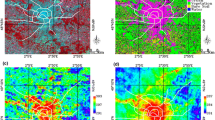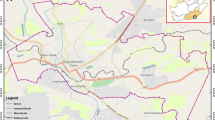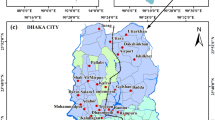Abstract
Urban Heat Island (UHI) is related to the theory of higher atmosphere and surface temperature taking place in the city area as compared to the nearby rural areas. The study results explain the advantages of green spaces in urban areas. Landsat TM/OLI concept of 1998 and 2017 years was attained from USGS for this work. To find out the land-use and land cover pattern supervised classification, the maximum prospect process is adopted. A total of four classes were mapped for the study area which includes built-up, barren land, vegetation, and water bodies. Effective sensor brightness temperature has been acquired from spectral radiance by using Plank’s reverse function. On the basis of surface emissivity, Normalize Difference Vegetation Index (NDVI) classes are used to find out the ultimate temperature of the land surface (LST). The maximum temperature was recorded in the built-up area and barren land of the city and minimum temperatures were noted in areas with a greater cover of vegetation. The presence of UHI temperature is obvious from the land surface temperature views. An increase of 2 °C in surface temperature is recorded in district Lahore during the last two decades. Rise of 2.2 °C and 2.4 °C surface temperature has taken place in Faisalabad and Multan Districts in the last 19 years, respectively. In the establishment of a correlation among the LST, built-up, and vegetation, there is a positive sign present in their relation. With the increase in the built-up area, LST does increase as well. Moreover, with the reduction in vegetation cover, the LST is also raised. The study has revealed that there is a need for proper planning for the durable management of urbanization.















Similar content being viewed by others
References
Acero JA, Kupski S, Arrizabalaga J, Katzschner L (2015) Urban climate multi-scale modelling in Bilbao (Spain): a review. Procedia Engineering 115:3–11
Amanollahi J, Tzanis C, Ramli MF, Abdullah AM (2016) Urban heat evolution in a tropical area utilizing Landsat imagery. Atmos Res 167:175–182
Anwar MM, Bhalli MN (2012) Urban population growth monitoring and land use classification by using GIS and remote sensing techniques: a case study of Faisalabad city. Asian J Soc Sci Humanit 1(1):5–13
Barnes KB, Morgan JM III, Roberge MC, Lowe S (2001) Sprawl development: Its patterns, consequences, and measurement. Towson University, Towson, pp 1–24
Buyadi, S. N. A., Mohd, W. M. N. W., & Misni, A. (2014). Impact of vegetation growth on urban surface temperature distribution. In IOP Conference Series: Earth and Environmental Science (Vol. 18, no. 1, p. 012104)
Cheng J, Masser I (2003) Urban growth pattern modeling: a case study of Wuhan city, PR China. Landsc Urban Plan 62(4):199–217
Congalton RG (1991) A review of assessing the accuracy of classifications of remotely sensed data. Remote Sens Environ 37(1):35–46
Elsayed IS (2012) Mitigation of the urban heat island of the city of Kuala Lumpur, Malaysia. Middle-East J Sci Res 11(11):1602–1613
Epstein HE, Paruelo JM, Piñeiro G, Burke IC, Lauenroth WK, Barrett JE (2006) Interactions of water and nitrogen on primary productivity across spatial and temporal scales in grassland and shrubland ecosystems. In Dryland ecohydrology (pp. 201–216). Springer, Dordrecht
Ghaffar A (2006) Assessing urban sprawl in Lahore by using RS/GIS techniques. Pakistan Geographical Review 61(2):99–102
Ghaffar A (2015) Use of geospatial techniques in monitoring urban expansion and land use change analysis: a case of Lahore, Pakistan. Journal of Basic and Applied Sciences 11:265–273
Ibrahim I, Samah AA, Fauzi R (2014) The review for the use of urban climatic map in the land use plan for urban planning. Urban Planning and Local Governance 3:95–110
Jothimani P (1997, October) Operational urban sprawl monitoring using satellite remote sensing: excerpts from the studies of Ahmedabad, Vadodara and Surat, India, vol 20. 18th Asian Conference on Remote Sensing, Malaysia
Katzschner L (2010) Urban climate in dense cities. In: Designing high-density cities for social, environmental sustainability, pp 71–83
Kaufmann RK, Seto KC (2001) Change detection, accuracy, and bias in a sequential analysis of Landsat imagery in the Pearl River Delta, China: econometric techniques. Agric Ecosyst Environ 85(1–3):95–105
Khan AA, Arshad S, Mohsin M (2014) Population growth and its impact on urban expansion: a case study of Bahawalpur, Pakistan. Universal Journal of Geoscience 2(8):229–241
Lata KM, Prasad VK, Badarinath KVS, Raghavaswamy V, Rao CHS (2001) Measuring urban sprawl: a case study of Hyderabad. GIS Development 5(12) Reproduced with permission of the copyright owner. Further reproduction prohibited without permission, 8-13
Matsuo K, Tanaka T (2014) Urban environmental climate maps for urban planning considering urban heat island mitigation in Hiroshima. Journal of Heat Island Institute International Vol 9:2
Moore BA, Kamilar JM, Collin SP, Bininda-Emonds OR, Dominy NJ, Hall MI et al (2012) A novel method for comparative analysis of retinal specialization traits from topographic maps. J Vis 12(12):13–13
Muñoz-Villers LE, López-Blanco J (2008) Land use/cover changes using Landsat TM/ETM images in a tropical and biodiverse mountainous area of central eastern Mexico. Int J Remote Sens 29(1):71–93
Raghavan K, Mandla VR, Franco S (2015) Influence of urban areas on environment: special reference to building materials and temperature anomalies using geospatial technology. Sustain Cities Soc 19:349–358
Reuter M, Fischl B (2011) Avoiding asymmetry-induced bias in longitudinal image processing. Neuroimage 57(1):19–21
Seto KC, Kaufmann RK (2003) Modeling the drivers of urban land use change in the Pearl River Delta, China: integrating remote sensing with socioeconomic data. Land Econ 79(1):106–121
Seto KC, Woodcock CE, Song C, Huang X, Lu J, Kaufmann RK (2002) Monitoring land-use change in the Pearl River Delta using Landsat TM. Int J Remote Sens 23(10):1985–2004
Sudhira HS, Ramachandra TV, Jagadish KS (2004) Urban sprawl: metrics, dynamics and modelling using GIS. Int J Appl Earth Obs Geoinf 5(1):29–39
Weng Q (2001) A remote sensing? GIS evaluation of urban expansion and its impact on surface temperature in the Zhujiang Delta, China. Int J Remote Sens 22(10):1999–2014
Weng Q (2002) Land use change analysis in the Zhujiang Delta of China using satellite remote sensing, GIS and stochastic modelling. J Environ Manag 64(3):273–284
Wong B, Candolin U (2015) Behavioral responses to changing environments. Behav Ecol 26(3):665–673
Wilson EH, Hurd JD, Civco DL, Prisloe MP, Arnold C (2003) Development of a geospatial model to quantify, describe and map urban growth. Remote Sens Environ 86(3):275–285
Xiao J, Shen Y, Ge J, Tateishi R, Tang C, Liang Y, Huang Z (2006) Evaluating urban expansion and land use change in Shijiazhuang, China, by using GIS and remote sensing. Landsc Urban Plan 75(1–2):69–80
Acknowledgments
The authors appreciate the Pakistan Metrological Department for their provision of the temperature data. Also, they are grateful to Sami Ullah Khan, Danish Raza, Muhammad Arshad for their constructive comments.
Author information
Authors and Affiliations
Corresponding author
Additional information
Responsible Editor: Philippe Garrigues
Publisher’s note
Springer Nature remains neutral with regard to jurisdictional claims in published maps and institutional affiliations.
Rights and permissions
About this article
Cite this article
Saleem, M.S., Ahmad, S.R., Shafiq-Ur-Rehman et al. Impact assessment of urban development patterns on land surface temperature by using remote sensing techniques: a case study of Lahore, Faisalabad and Multan district. Environ Sci Pollut Res 27, 39865–39878 (2020). https://doi.org/10.1007/s11356-020-10050-5
Received:
Accepted:
Published:
Issue Date:
DOI: https://doi.org/10.1007/s11356-020-10050-5




